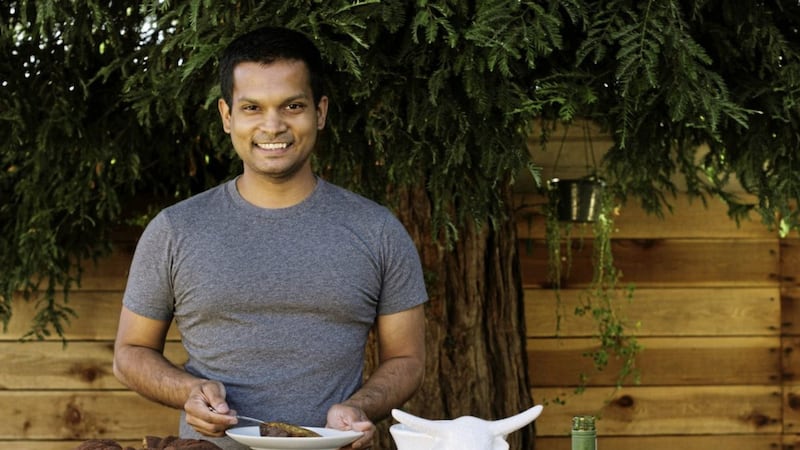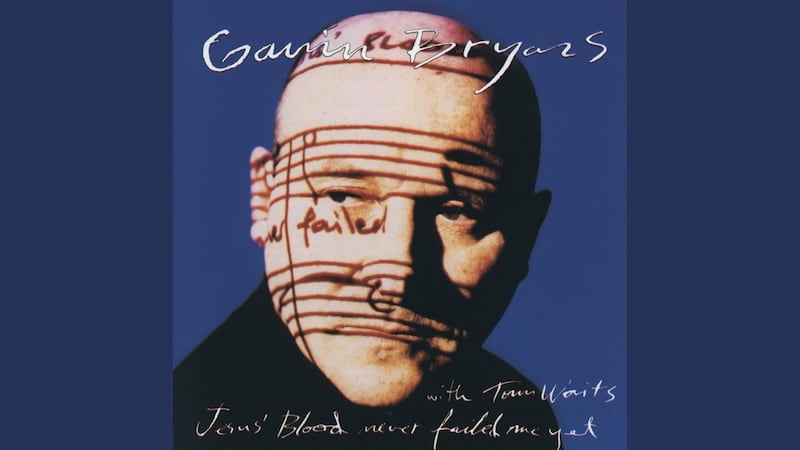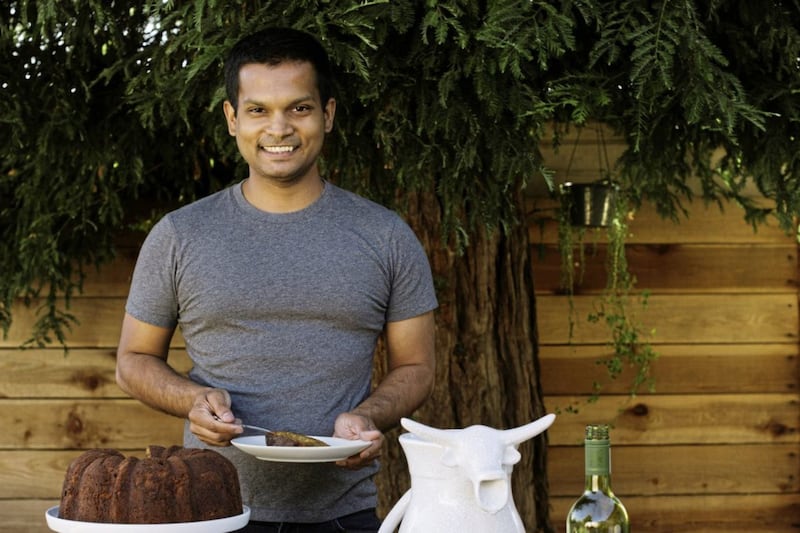WRITER, photographer and food stylist Nik Sharma is based in Los Angeles, a city of farmers’ markets and cutting-edge restaurants, tacos you’d sell a limb for (if pushed), and ridiculously fresh produce.
“The food scene in LA is the most vibrant in the US,” says Sharma. “You can get the most delicious and inventive meals at different price points, so everyone has access, which is amazing. Mexican food, obviously, is the best – in my opinion.
“It’s also always unexpected,” he adds. “You never know what you’re going to walk into and that’s what I love.”
Covid has put a hold on much of that, however. LA’s been badly hit and Sharma misses the restaurants – and simple things like “going to the store, picking things out, the tactile feeling” of holding a lemon before popping it in a basket.
Like most of us, he’s been cooking a lot at home. But as a food writer who cooks at home for a living anyway, he admits during the pandemic he’s had to remind himself he “can’t make desserts all the time, I need to cook savoury food…”
If you’re new to Sharma’s food, he describes it “adventurous and fun” and “unbound by any shackles or rules. It’s more defined by what flavour is – and what it could be.”
At its core is an awareness of science and the role of science in the kitchen. With his new cookbook, The Flavor Equation, he’s “trying to show that science and cooking coexist harmoniously in the kitchen” and that neither side needs be afraid of the other. “I want people to see the kitchen is a lab,” he notes. “What you’re doing in the kitchen, it’s actually science.”
Born in Bombay, Sharma relocated to the US to study molecular genetics, before deciding food was the one for him (much to his parents’ chagrin – they have come around now). Writing recipes that he shoots and styles himself, his work appears in the New York Times, the San Francisco Chronicle and on his blog, A Brown Table.
The Flavor Equation follows his debut cookbook, Season, and sees him using science to extract deliciousness; investigating how perception affects how we eat; and considering the impact of emotion, sight, sound, mouthfeel, aroma and taste on flavour.
The recipes, meanwhile, “provide experimental basis, and they’re fun” says Sharma – essentially, they’re the practical portion. We learn about fieriness through chicken lollipops, savouriness via stir-fried cabbage, sweetness thanks to masala cheddar cornbread, and bitterness due to a shaved Brussels sprout salad – picking up snippets of science with each page.
It’s sensible, useful stuff too; not complicated formulas your science teacher would have thrown at you. For instance, explains Sharma, “some pigments are fat soluble, some are not, you don’t want to stain your hands when you’re working with beets – we know that the pigments in beets are water soluble. So, if you add water, it’s going to stain everything. Now if you rub oil all over the place, it won’t stain.” That alone will save your palms and work surfaces from turning hot pink.
Beyond the science, when he it comes to cooking, Sharma thinks an “ability to experiment” and “willingness to fail” are both crucial.
“I’ve always noticed that when I fail in the kitchen, I’m driven to find out what went wrong, and then fix it. Trying to solve that process, or getting to the fixing part, is where you learn a lot,” he muses. “That makes you wiser, because not only will you learn to fix that mistake but you can then take and apply that knowledge elsewhere.”
Sharma ate a lot of seafood growing up on the west coast of India, alongside the meat-driven food of his mother’s background in Goa, formerly a Portuguese colony and so European influenced. American cuisine has since filtered in, alongside the words of what Sharma calls the “Holy Trinity” of food writing: British cooks and food writers Nigella Lawson and Nigel Slater and Northern Ireland cook Diana Henry.
He’s also a huge Great British Bake Off fan (“I watch it after the entire thing comes out, so I can just binge”).
Sharma says a concern he has with a lot of cookbooks that focus on food from different countries is the fixation with props. “Indian cooking, for example – there’s always this tendency to show old props [bowls, plates, glasses etc.]. Having lived in India, we never ate from an old rusted bowl.”
This exoticising and romanticism of certain food cultures, and how they ought to be presented is problematic he says, when the “reality is, most people just eat very simply every day.”
The Flavor Equation: The Science Of Great Cooking Explained + More Than 100 Essential Recipes by Nik Sharma, is published by Chronicle Books, priced £26. Photography by Nik Sharma. Below are two recipes from the book for you to try.
MASALA SHRIMP
(Serves 4 to 6 as an appetiser)
455g raw medium shrimp, peeled and deveined, tails left on
2tbsp extra-virgin olive oil
2 garlic cloves, peeled and grated
2.5cm piece fresh ginger, peeled and grated
2tbsp tomato paste
1tbsp fresh lime juice
1tsp garam masala
½tsp ground cayenne
¼tsp ground cinnamon
Fine sea salt
2tbsp minced chives, for garnish
1 lime, quartered, for garnish
The Flavor approach:
The heat from the cayenne and spices in the garam masala are amplified by the addition of the lime juice. Lime juice also helps denature the proteins in the shrimp, which cook even faster once heated, so do not over-marinate the shrimp, or they will get rubbery.
Method:
Rinse the shrimp under cold running water, pat dry with clean paper towels, and place in a large bowl.
Combine one tablespoon of the oil and the garlic, ginger, tomato paste, lime juice, garam masala, cayenne, and cinnamon in a small bowl. Add the shrimp, season with salt, and fold to coat evenly. Let sit for five minutes.
Heat the remaining one tablespoon of oil in a medium stainless-steel or cast-iron skillet over medium-high heat. Add the shrimp with the liquids in the bowl to the hot oil and sauté until they turn pink, three to four minutes. The tomato paste and shrimp might make it tricky to determine the pink colour, so cut a piece of the shrimp in half; the flesh inside should be completely tender and white in addition to the outer surface and tail turning pink.
Transfer the shrimp to a serving plate. Garnish with the chives. Serve immediately with the lime quarters on the side.
LAMB CHOPS WITH SCALLION MINT SALSA
(Serves 4)
For the lamb:
8 lamb rib chops (total weight 910g)
60ml fresh lemon juice
4tbsp extra-virgin olive oil
1tsp amchur
1tsp ground black pepper
1tsp red chilli powder
1tsp fennel seeds, coarsely cracked
2tsp or more kala namak
For the salsa (makes 360ml):
120ml extra-virgin olive oil
60ml fresh lemon juice
1 bunch fresh mint (55g), chopped
4 spring onions, both white and green parts, thinly sliced
4 garlic cloves, peeled and minced
1tsp ground black pepper
1 fresh green chilli, minced
Fine sea salt
The Flavor approach:
Kala namak, or Indian black salt, acts as the brining salt and also as a flavouring agent for the meat. The combination of salt and acid in the marinade changes the lamb’s protein structure. In the case of red meat, the tough collagen starts to solubilize, and the tissue swells as it retains water and is tenderised. The cooked meat will be tender and juicy.
Method:
To prepare the lamb, pat the chops dry with clean paper towels and place them in a large resealable bag. In a small bowl, mix the lemon juice, two tablespoons of the olive oil, amchur, black pepper, chilli powder, fennel, and kala namak and pour over the lamb chops in the bag. Seal the bag and shake to coat the chops well. Leave the chops to marinate in the refrigerator for at least two hours, preferably six hours.
An hour before you’re ready to cook, prepare the salsa. In a lidded bowl, mix the olive oil, lemon juice, mint, spring onions, garlic, black pepper, and chilli. Taste and season with salt. Cover and let stand until ready to serve.
When you’re ready to cook the chops, leave them in the plastic bag out on the kitchen counter for at least 15 minutes to warm to room temperature.
Cook the marinated chops in batches. Heat the remaining one tablespoon of olive oil in a large stainless-steel or cast-iron skillet over medium-high heat. When the pan is hot, lift four chops out of the bag with a pair of kitchen tongs and place them on the hot pan for three to four minutes per side for rare and five to six minutes per side for medium-rare (on an instant-read thermometer, 62.8C for rare and 71C for medium-rare). Repeat with the remaining one tablespoon of olive oil and the remaining chops. Transfer the chops to a plate, tent loosely with foil, and let rest for five minutes before serving.
Before serving, garnish the lamb with the scallion mint salsa. Serve warm.



